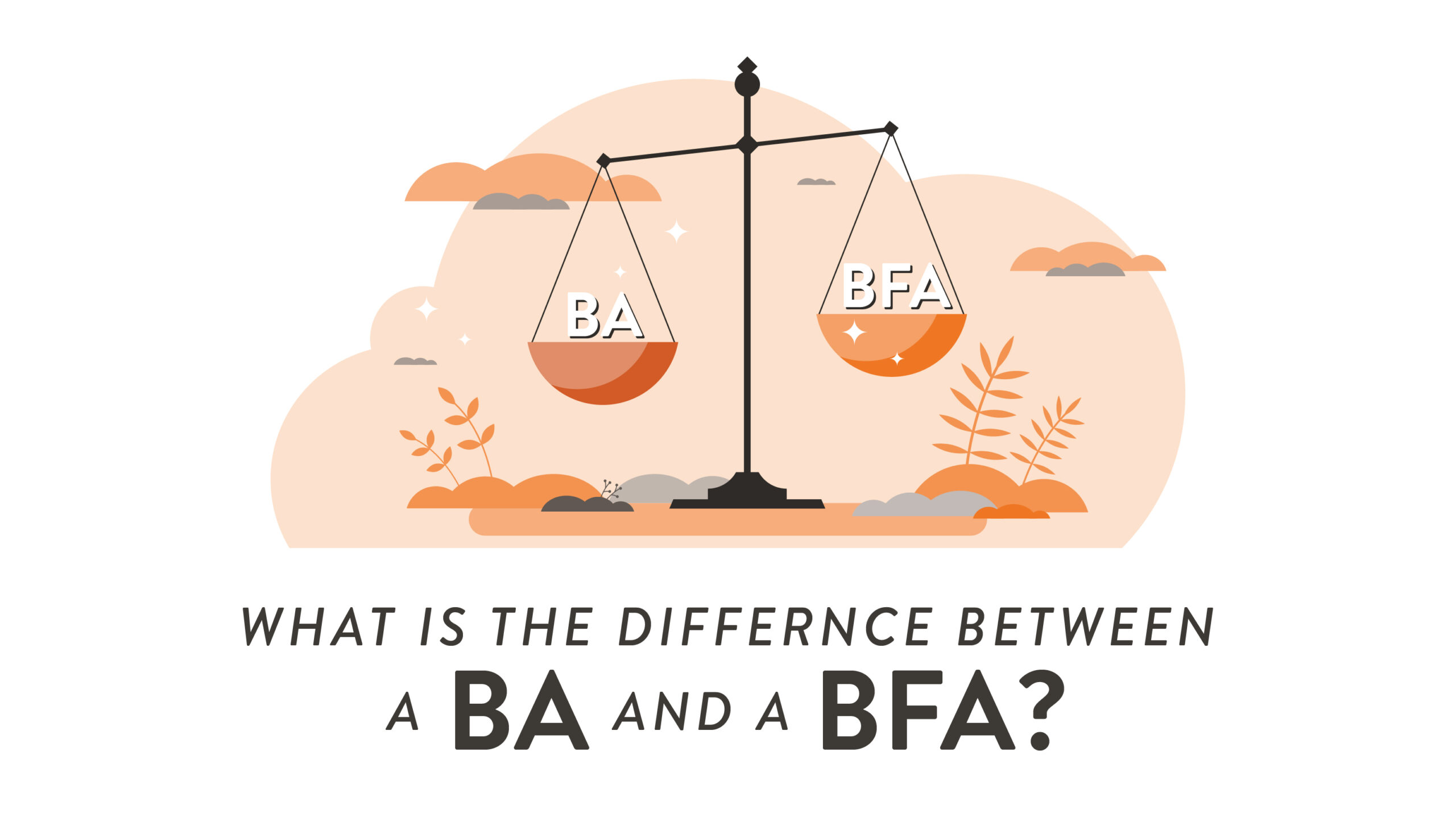As you likely know, B.A. stands for Bachelor of Arts and BFA stands for Bachelor of Fine Arts. However, do you know the difference between these two degrees? While they both empower students to learn more about their areas of study, each degree has distinct differences. In this blog, you will learn the similarities and differences between a B.A. and a BFA, and which degree path might be right for you!
Understanding the Bachelor of Arts (B.A.)
A lot goes into the design of a bachelor’s degree, Bachelor of Arts requirements emphasize a diverse range of topics.
Curriculum Focus
National University says this degree focuses on advancing knowledge rather than honing creative technique and skill. According to All Art Schools, two-thirds of the degree’s coursework is a liberal arts degree, which offers more general education, and one-third of B.A. curriculum is focused on the specifics of a student’s chosen major. This means a Bachelor of Arts is designed to prepare students with critical thinking skills, communications, and foundational knowledge in the humanities.
Areas of Study
Students enrolled in a Bachelor of Arts program have a wide array of options when it comes to fields to study, many of which you may not immediately associate with the word art, such as politics, religion, economics, and criminology – in as well as visual art, according to the University of Sydney.
Understanding the Bachelor of Fine Arts (BFA)
What is a BFA degree? A Bachelor of Fine Arts or BFA has much in common with a B.A. However, the curriculum prioritizes a more specialized learning style.
Curriculum Focus
BFAs emphasize the importance of creation in and outside of the classroom. All Art Schools also states that while BFA programs include some liberal arts education, this only accounts for around a third of BFA curriculum, instead focusing on honing the student’s creative skills in a particular area of focus. This means the other two-thirds of the curriculum is a mix of theory, history, and studio time of the chosen major’s craft. According to Coursera, BFA programs are also more likely to be in-person with synchronous classes. This option gives a deeper dive into a single discipline.
Areas of Study
In keeping with the program’s emphasis on creation, a Bachelor of Fine Arts degree presses the importance of students making some form of media, such as a painting, a dance, or a song. According to Coursera, BFA fields of study are specific to art, such as film, ceramics, and music theory.
Key Differences in Educational Approach
There is a big difference between B.A. and BFA education. Students looking at graduation requirements will need to know how their degree is designed.
Course Structure and Requirements
Admissions requirements may differ between the two degrees, even at institutions that offer both degrees. As US News states “It’s also common for B.A. and B.F.A. programs to have different admissions requirements… B.F.A. programs often require prospective students to submit a portfolio of their artwork or audition.”
Depth vs. Breadth
Depending on what a student is looking for in their education, they may desire the depth of a BFA or the breadth of a B.A. When deciding between these two learning styles, students should consider their career goals after graduation. Depending on the field a student may prefer to be a jack of all trades or a master of one. Many positions collaborate with members of different industries or departments, thus having a wide range of knowledge can be helpful. At the same time, being a specialist in your field of work may also prove advantageous.
Career Paths and Opportunities
When prospective students select a degree pathway, one of the biggest considerations is how it will affect their employment beyond school.
Careers with a B.A.
Students can receive a Bachelor of Arts in several areas, such as journalism or history. Therefore, not all B.A. graduates are even artists. When beginning a career, not all B.A. graduates are qualified for the same positions. These students instead share educational fundamentals, which might include math, anthropology, or english. B.A. degree careers vary widely from person to person.
Careers with a BFA
The specialized education that BFA graduates possess may be ideal for a candidate who knows exactly which field they want to pursue as BFA degree careers are more specific to visual arts.
Choosing the Right Degree for You
Choosing a B.A. vs. BFA can be overwhelming. A vital question for students to answer is; how focused do they want to be on the arts?
Factors to Consider
Consider how B.A. curriculum and BFA curriculums have different liberal arts requirements. A four-year degree means hundreds of hours spent studying, so it is important that students choose the appropriate path.
Student Pathways
Most colleges and universities allow students to enroll as undeclared, which means they have yet to declare a major by the time coursework begins. This is a good opportunity for students who are still determining a major. For undeclared students or even just those who are uncertain, liberal arts education exposes them to an array of options. Alternatively, many college freshmen know exactly the degree they want.
Educational Outcomes and Further Studies
The impact any degree will have on a graduate extends far beyond the classroom.
Graduate Studies Options
When it comes to deciding on a bachelor’s degree, an important consideration for students might be whether or not they intend to pursue a more advanced degree later in life. Most graduate programs look for “A bachelor’s degree in your subject area (some institutions are flexible about specializations)” says Coursera, meaning what a student studied is often more important than the type of degree they received. Finally, students can’t forget to work on their art portfolio, according to Azusa Pacific University artistic potential cannot be measured through grades alone. That’s where (an) MFA portfolio comes into play.”
If a student believes a master’s degree is in their future, they may want to specialize in their pursuit early on in their education and get a BFA. However, that same student may prefer a B.A. to get more out of their liberal arts education before specializing in their graduate program. Similarly, for those looking to pursue an advanced degree, you can receive a Master of Arts (M.A.) or a Master of Fine Arts (MFA), which have similar breadth and depth to their bachelor counterparts.
Long-term Professional Impact
Education is a huge factor when seeking employment. As of 2023, high school graduates had an unemployment rate 1.7% higher than graduates with a bachelor’s degree, according to the US Bureau of Labor Statistics. However, the most valuable part of any student’s education is the skills they learned.
In the end, only you can decide which type of degree is best for you. Consider the factors of curriculum, graduate studies, and career options, but most of all, research individual programs at each college or university you are considering applying to. Every program is different and there are dozens of unique considerations you will face.
Interested in beginning your BFA now?
Looking to start your creative career? At Rocky Mountain College of Art + Design, you can receive a world-class education in the arts with any of our 11 program paths. With accredited BFAs on-campus or online, you could pursue a bachelor’s in art education, photography, interior design, and more! Request information today.

